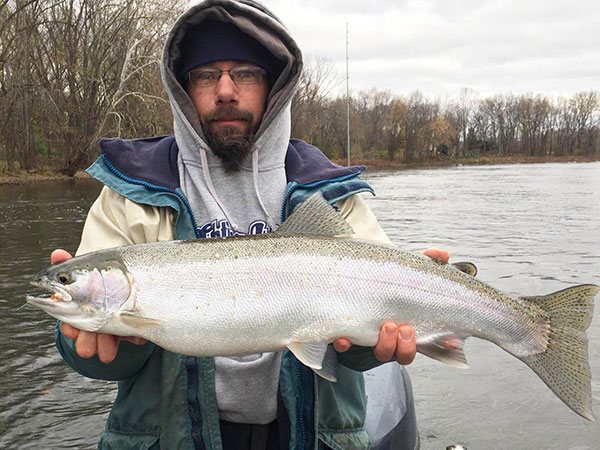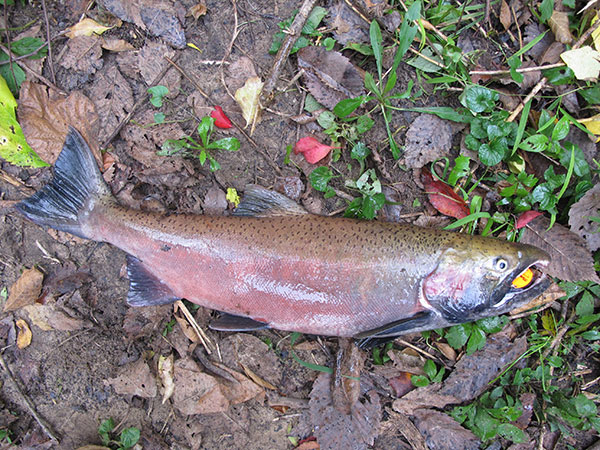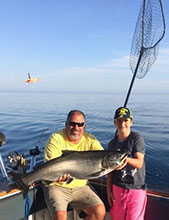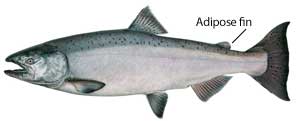- Details
By Louie Stout
 Winter Steelheading Can be Productive for Hardy Anglers
Winter Steelheading Can be Productive for Hardy Anglers
A dilemma for steelhead anglers occurs every winter: The St. Joseph River is full of steelhead, but it's snowy and it's cold.
How badly do you want to catch them?
Mike Jones of Mishawaka wants to catch them badly. Fishing's in his blood - year-round. When he's not chasing steelhead or walleyes in the winter, he's trying to outfox catfish or bluegill at other times of the year.
That's why he spends as much time as he can on the river and his success speaks for itself.
"Last year, my fishing partners and I caught 137 steelhead from late October through March," he said.
With more fish in the river this year, December through March should be even better.
If you can handle the weather.
- Details
By Louie Stout
 Big Numbers of Coho Invade St. Joe
Big Numbers of Coho Invade St. Joe
You better re-string those river rods and reels with new line and load up on spinners and spawn.
The South Bend and Mishawaka sections of the St. Joseph River are filling up with trout and salmon.
That’s right…salmon. Coho, to be exact.
The steelhead appearance is no surprise. They’ve been trickling in since early June. We have about 2,500 in the upper river now, which is pretty good compared to previous years.
But the early showing of coho - and big numbers of ‘em - has been a surprise to both anglers and fish managers.
“We’ve counted 3,600 coho move into South Bend the first 15 days of September,” said Lake Michigan biologist Brian Breidert. “That’s pretty remarkable.”
It sure is. You will have to go all the way back to 1997 to see coho numbers like that entering Indiana waters at such an early stage.
- Details
(Provided by Michigan DNR)
 Michigan DNR Predicts Better Salmon Fishing AheadLake Michigan has had a tough couple of years, especially as it relates to fishing for salmon. After a few years with a low population, fishing really picked up this past spring. Anglers on the lake experienced limit catches of coho and Chinook salmon thanks to some improvement in the numbers of bait fish available.
Michigan DNR Predicts Better Salmon Fishing AheadLake Michigan has had a tough couple of years, especially as it relates to fishing for salmon. After a few years with a low population, fishing really picked up this past spring. Anglers on the lake experienced limit catches of coho and Chinook salmon thanks to some improvement in the numbers of bait fish available.
Lake Michigan has experienced some historic low bait levels in recent years due to harsh winter conditions, less available nutrients resulting from invasive quagga mussels, and over predation from salmon and trout. But Mother Nature, working as she normally does, provided more moderate temperatures the last couple of winters that have allowed bait fish like alewife, smelt, bloaters and lake herring to reproduce and survive.
"The 2015 and 2016 year classes of bait are much better than previous years," said the DNR's Lake Michigan Basin Coordinator Jay Wesley. "These bait fish are helping to support the improved salmon fishery this year."
- Details
(Provided by MDNR)
The Michigan Natural Resources Commission approved fishing regulation changes regarding lake trout and splake in lakes Michigan and Huron and Type F drowned river mouth lakes.
The regulation changes, which are now in effect, will result in expanded angling opportunities, including:
- Details
(Provided by MDNR)
 Report Marked and Tagged Salmon/>The Michigan DNR again this year is encouraging Great Lakes anglers who catch marked and tagged fish to report them.
Report Marked and Tagged Salmon/>The Michigan DNR again this year is encouraging Great Lakes anglers who catch marked and tagged fish to report them.
The DNR has used the coded-wire tag program to mass mark various fish species in Michigan since the 1980s. Mass marking provides critical data as fisheries biologists look to determine the value of naturally reproduced fish versus stocked fish, and lakewide movement of fish.
The coded-wire tag program involves implanting a small, coded-wire tag, which is invisible to the naked eye, into the snout of a fish. A fish containing a coded-wire tag can be identified because its adipose fin (the small, fleshy fin between the dorsal and tail fins) has been removed. An angler who catches a tagged fish then can record needed information about the fish, remove and freeze the fishís snout, and drop it off at a designated location. A statewide list of dropoff locations can be found on the DNR website.
For years the DNR primarily tagged Chinook salmon and lake trout as part of its mass marking effort in Lake Huron. Tagging these fish has helped biologists understand more about lakewide natural reproduction and how many wild fish are available in the Great Lakes. It also has helped determine if the percentage of wild fish varies from year to year and how fish stocking locations contribute to lake and river fisheries. Additionally, it provides insight into fish movement and where fish are stocked compared to where they are caught.
Because of the value of the information the mass marking effort brings, the DNR, in conjunction with the U.S. Fish and Wildlife Service, has continued to coded-wire tag all lake trout, Chinook and Atlantic salmon stocked into lakes Huron and Michigan, as well as a subsample of rainbow trout (steelhead) from the Au Sable River.
"We rely heavily on Michiganís anglers to return tagged fish and are appreciative of their cooperation," said Randy Claramunt, the DNR's Lake Huron Basin coordinator. "Participating in the DNRs mass marking effort allows us to learn more about the states fish species so we may manage them more effectively in the future."
Because of the vast number of fish marked by this method (millions annually), there are no longer rewards given to anglers for returning tagged fish. Any angler returning a coded-wire tagged fish to the DNR now will receive a letter describing the history of the fish caught (such as stocking location and age).
To learn more about the DNRs mass marking efforts, visit michigan.gov/taggedfish.





